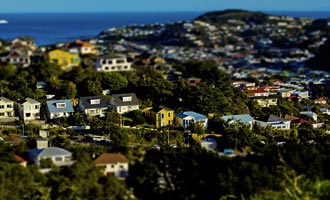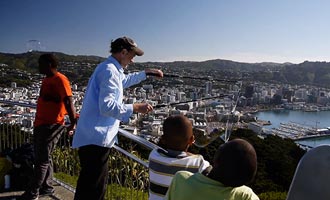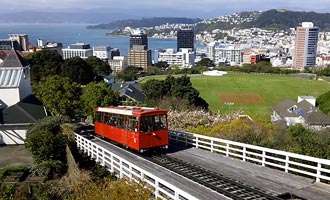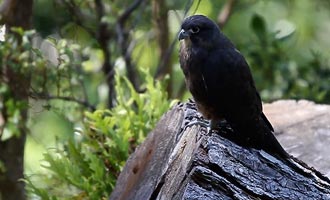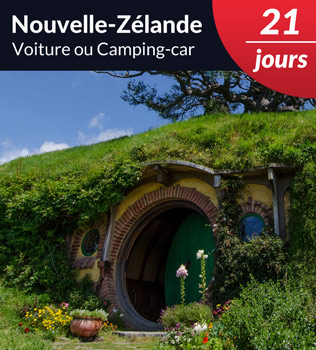
Wellington, Capital of New Zealand.
Please contact us and we will help you to organize your trip! It's free and without commitment.
- Read the post
- Details
- Advices
Schedule of the Visit.
- 1A Day in Wellington.
- 2The Happiness of Living near the Beach.
- 3Te Papa, the Best Museum of New Zealand.
- 4Shopping Break in Lambton Quay
- 5Explore the Botanical Garden & Zealandia.
- 6Good Vibes from Cuba to Courtenay!
- 7Wellington, Most Beautiful City in New Zealand?
A Day in Wellington.

The capital of the country is also the one of movie special effects.
If the capital of New Zealand is nicknamed Wellywood, this is because of Peter Jackson. The Kiwi director of the Lord of the Rings and the Hobbit created the famous Weta studios, famous for the quality of their special effects.
Wellington evokes especially San Francisco city which was built during the same period.
Both cities share the same architectural style, with charming Victorian villas built on a hillside overlooking a beautiful bay.
Do not expect me to play the game of the seven differences. I am not familiar enough of San Francisco, but I am a great lover of Wellington, which remains my favorite city in New Zealand by far.
This is a must-do visit, and a stopover that should be included in every New Zealand trip.

Wellington is the departing point for the South Island.
You'll find it on a map, in the southwest of the North Island, near the Cook Strait which separates the two main islands of the country. Spread over several bays Wellington is located in the roaring forties. This is probably why its 180,000 inhabitants nicknamed her of “Windy Welly”. The wind gusts rushing into the Cook Strait are famous to return the umbrellas, but people here don't care, probably because their city enjoys a mild oceanic climate, pleasant throughout the year.
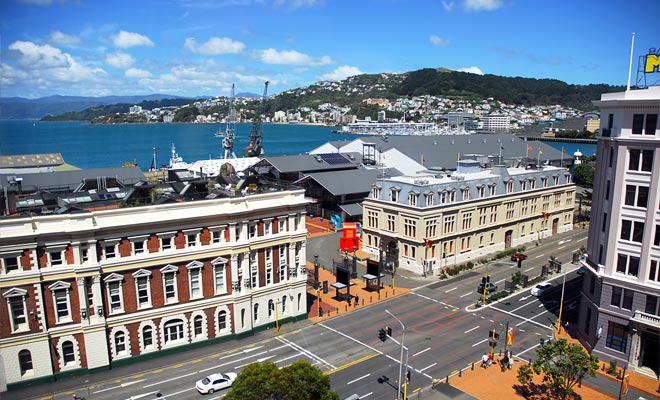
Wellington owes its nickname of Windy Welly to its gusts.
The tour operators usually plan the visit of Wellington halfway through a circuit spread across the two main islands. A decision which allows less than one day to explore the city, before joining the Interislander ferry company. How could you enjoy the city in such a short time? One cannot explore a capital in less than 24 hours! But do not worry, you can follow Kiwipal's tailor-made itinerary instead!
My original itinerary reveals the many faces of Wellington.
We will explore the city on foot most of the time, but the trolleybuses cover a great part of the city center and a ticket only costs $6 a day, so why not using it? Regarding the itinerary, I have also planned some nice surprises ... So, is Wellington the most beautiful city in New Zealand? You'll tell me after your visit!
The Happiness of Living near the Beach.
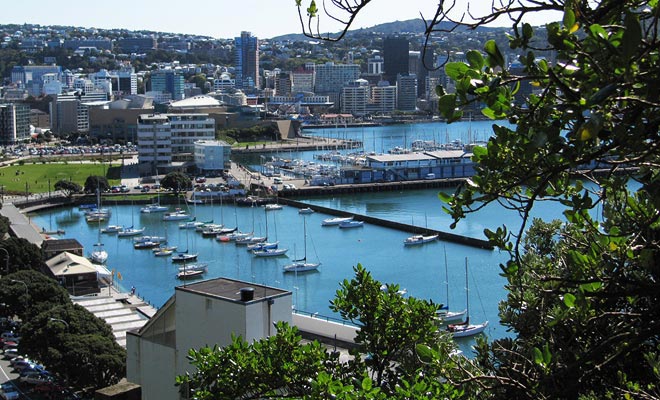
The Waterfront District was a port before.
Former Wellington Harbour, the Waterfront District has been renovated to offer a vast recreational area close to the city center. The superficy was increased thanks to many extensions reclaimed from the sea, at the cost of considerable efforts.
For once a catastrophy served a purpose ... the great earthquake of 1855 raised the coast of several meters, ironically saving millions of dollars! The promenade along the quays to Frank Kitts Park is known as “Wellington Writers Walk”.You'll find many famous quotes carved into stone. Their authors have in common to have traveled and lived in Wellington during their lifetime.
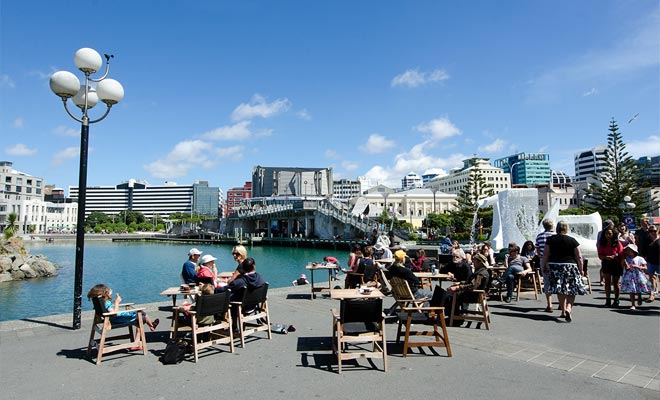
The walk of Wellington Writter Walks runs alongside the docks.
It's true you can't live here by chance, you have to do and be, not simply watch or even describe. This is the city of action, the world headquarters of the verb.
Lauris Edmond
We will vist the beach of Oriental Bay to enjoy the first rays of the sun. Some residents are already practicing jogging or roller skating along the docks.
The most motivated locals are booking kayaks or paddle boats. Here, the waves are not strong enough for the surfers, but there are many surf spots a little further into the bay.
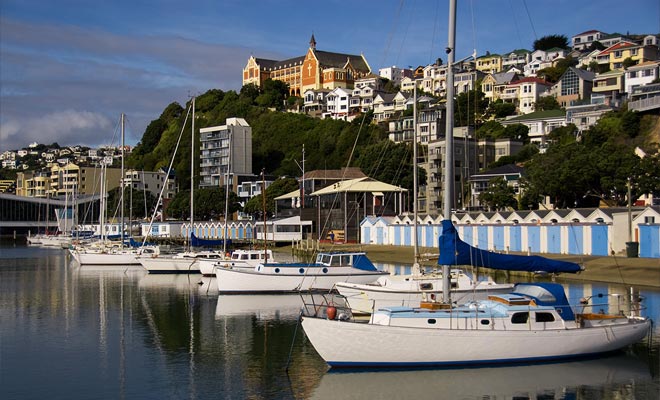
The beach of Oriental Bay and its Victorian houses.
You should take off your shoes to finish the walk in the sand of the beach.
If you desire to put your feet in the water, you're welcome! On my side I'll try to spot some dolphins. They can be observed from time to time, usually when they visit the harbour to play in the waves.
Turn your back to the beach for a minute to admire the lovely 1900 villas surrounding the old church of St Paul, on the slopes of Mount Victoria. If you're still here tomorrow, we may climb to the top to enjoy unrivaled views of the bay.

The Civic Center hosts festivals in the summer.
For now, we will retrace our steps to find the entrance of the Civic Center.
This large plaza decorated with elegant palm sculptures connects all the districts together. It serves as gathering place for many outdoor festivals, and is a great place to enjoy a relaxing brunch at a terrace.
At the center of the place I advise you to look up to the sky to contemplate a splendid artwork created by Neil Dawson.
The steel sphere that seems to float in the air represents five varieties of ferns intermingled. The cables which hold the sphere can't be easily spotted, making the visual effect stunning.
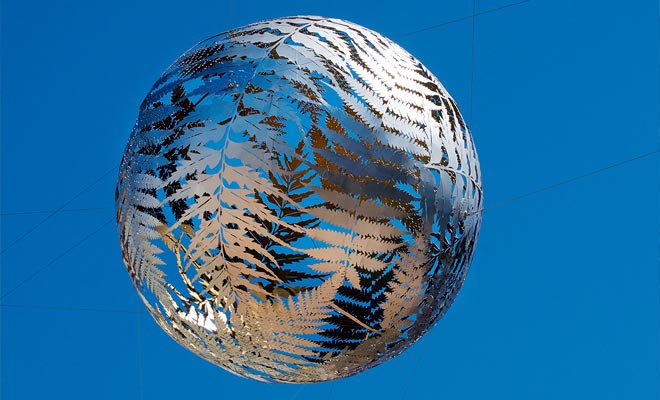
Symbol of the country, the fern is represented by this sculpture.
I let you choose between a coffee and a visit of the various buildings surrounding the Civic Center. They mostly offer an interesting mix of contemporary and classical architecture.
You can collect a free city map at the iSite or have a look at the vast library, but do not spend too much time here, because the Te Papa museum is waiting for us...
Te Papa, the Best Museum of New Zealand.

The Te Papa is the largest museum in New Zealand.
The National Museum was built at the extraordinary cost of 317 million dollars and required 13 years of hard work. Opened to the public in 1998, the Te Papa possesses six ultramodern floors with a superficy equivalent to three rugby fields.
Each year, more than one million visitors explore the most popular museum of New Zealand. Despite the record attendance, you won't feel oppressed by a crowd during your visit.
Designers have privileged empty space so you can breathe, even if it implies reducing the number of art works exposed. In the Maori language, Te Papa Tongarewa means “The treasures of our land”.
The museum aims to tell the history of the country since its volcanic origins, up to the contemporary period.
This is the best place to be initiated to the Maori culture, above all because permanent collections are free. Very well designed, each floor has its own central theme.

The Te Papa is not a museum like the others ...
Each gallery has its own subtle lighting, which allows to enhance the artworks visual quality. Video projections and splendid reconstructions make of the entire museum an exciting place to visit, even with children.
Before starting the visit, how about a walk in the woods? Not far from the entrance you'll find a bush followed by a volcanic landscape. Then comes a lagoon with a waterfall, and even a glowworms cave that recalls the famous ones in Waitomo.
This is just amazing ! And I confirm that this is not a basic reconstruction, but a wonderful place that worth a quick visit.
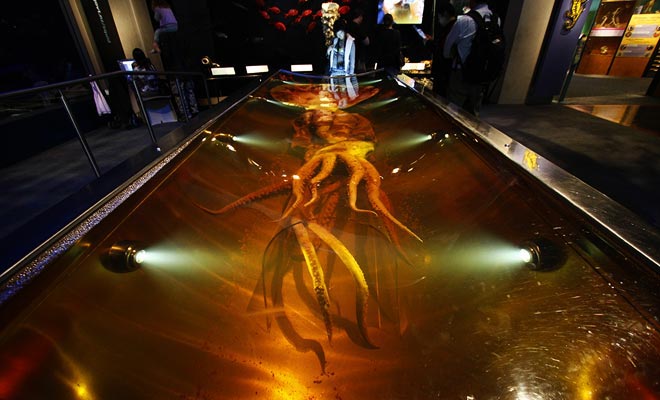
The largest giant squid in the world is kept intact.
You'll find your pleasure here, but not knowing what you prefer, I won't describe all the floors in detail one by one. But perhaps I should introduce briefly what I enjoyed the most during my many visits. At the second floor, you will shudder before the largest giant squid of the entire world. This creature is a wonder of nature (or a horror, as you wish...) and it is 4 meters long with a weight of half a ton! I challenge you to look into the 28 cm eyeballs of this marine monster!
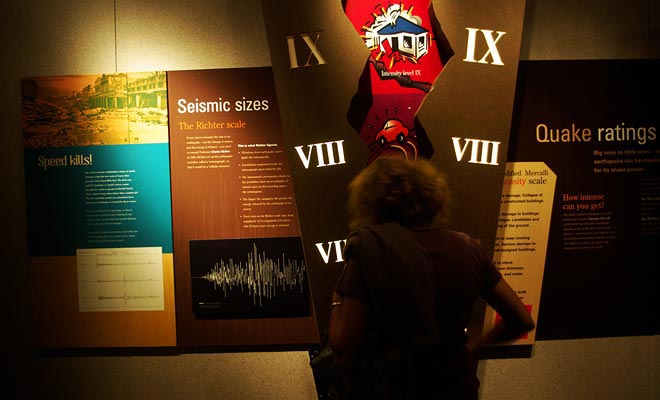
Part of the museum is devoted to earthquakes.
Did you ever ask yourself how it feels to undergo a massive earthquake?
Follow me in a small house mounted on hydraulic jacks. At regular intervals, the installation reproduces the effect of a powerful earthquake.
The furniture start to dance and the walls lean while you try not to fall on the ground...
If you are passionate about the volcanoes, you'll adore the “Blood Earth Fire” exhibition.
New Zealand is a volcanic land located on the mighty Pacific Ring of Fire. You will understand the origin of the earthquakes that shake the two islands each year. The entire gallery is fun and never boring.
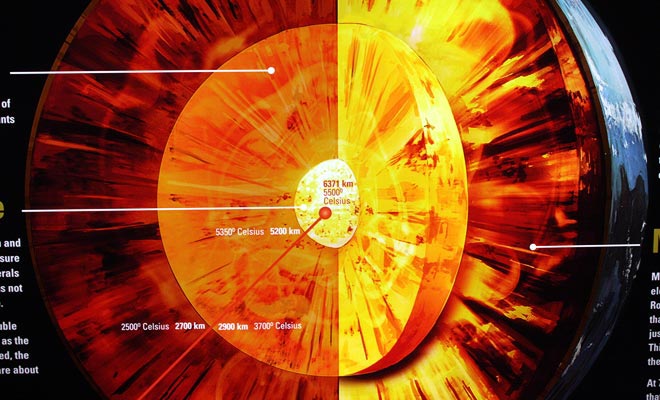
Blood Earth Fire will delight lovers of volcanoes.
Then climb to the fourth floor to immerse yourself into the Maori culture. You will visit a “marae”, an authentic carved wooden Maori house. Do not miss the famous “wakas”, the war canoes carved from the trunks of giant Kauri trees! If only all museums could be like the Te Papa Tongarewa ...
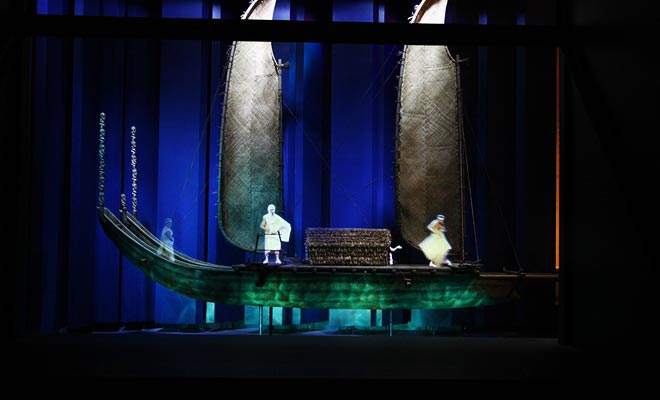
An important place is given to Maori culture.
It is already noon and we still have a entire city to visit! But we have just enough time for an express visit at the beautiful gift shop of the museum.
So, don't stay too long in the shop and come join me after, I'll be at the Te Papa Cafe at the first floor.
Usually, I do not appreciate much the museum restaurants. But this one is an exception as it serves decent and affordable meals.
This will save us time and we will continue with the city visit right after.
Shopping Break in Lambton Quay

Lambton Quay is the main business district of the capital.
After reloading our batteries with a good meal, we will follow an easy walk in the district of Lambton Quay. It is the “Golden mile” of Wellington, with all the major shopping centers and the most famous shops.
But it has not always been the ideal place to go shopping... At the era of the first settlers, you would have had your feet in the water right here! The entire area was reclaimed from the sea for decades. Look at these marks on the curb, they indicate where the shore was during the 19th century.
However, Lambton is not just a succession of arcades or shopping streets.
This is Wellington Central Business District (CBD) where modern buildings coexist with elegant constructions from the 19th century.
This is a very dynamic place, with great energy until the close of business late in the afternoon.
The famous Backbenchers Pub that we just saw along the street also welcomes politicians.
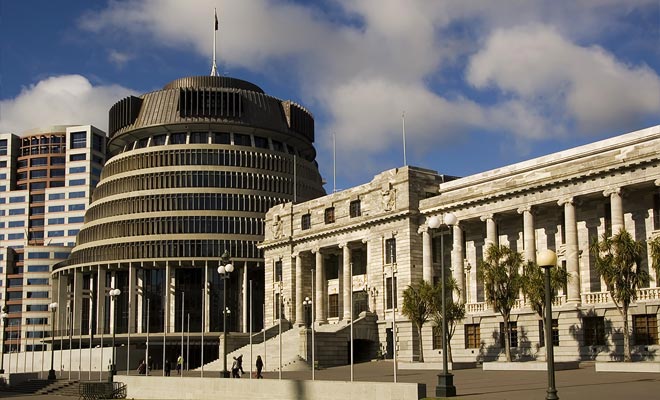
Nicknamed Beehive (the hive), the parliament created controversy.
Speaking of politics, I must show you the New Zealand Parliament on Bowen Street. This strange building is nicknamed Beehive, and everyone has an opinion about it, but mostly, you will love it or hate it for sure!
If you prefer a more traditional style, you can admire the old parliament of 1876. It now houses the Faculty of Law and the Department of Conservation. This beautiful Renaissance building is built entirely with kauri wood.
Paradoxically, this noble material which was the cheapest during the settlers era, would cost you a fortune today.

The old parliament seems made of stone, but it is made of wood!
The rest of the district is occupied by government departments. I guess you are not interested in these, so we'll change our itinerary to reach a highest place in the hills.
The cable car from Lambton Quay will help us to reach the next visit planned today.
We just miss it, but this is a great opportunity to explain you why Wellington was built on the hillside.
In 1840, the first settlers land in pouring rain to establish a city which had to be called Britannia. Swollen rivers carry away the wooden houses and jeopardize the future of the colony. Anyway, failure is definitely not an option, and it is decided to move the city location towards Lambton Harbour.
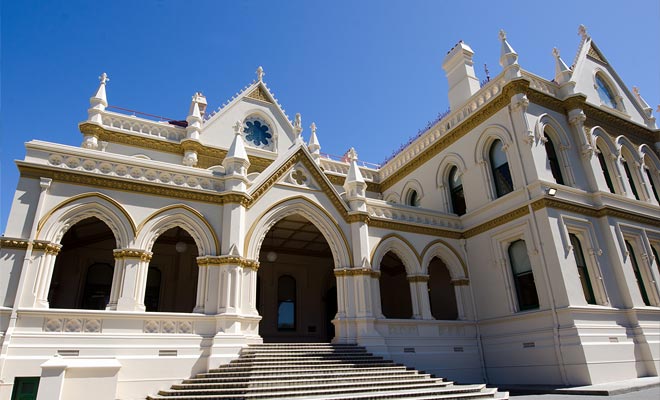
The library has an original architecture.
To celebrate the victory of Waterloo, settlers also decide to rename their colony to pay honour to the Duke of Wellington.
But the city plans imagined in London do not fit any more with the new location. Since nobody wants to undertake a six-month journey round trip to revise the plans, the decision is made to follow them, even if establishing the city on a hillside was a crazy idea!
Now you know why the streets of Wellington are so inclined and why we can count 400 funiculars (which is a world record).
This is also why the population constantly try to reclaim lands from the sea.
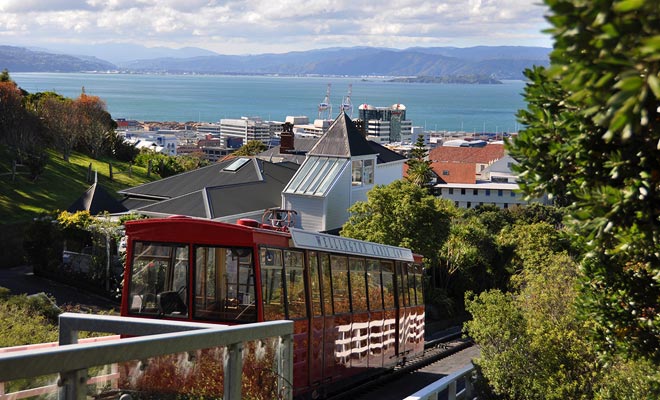
The funicular takes you to the Botanical Garden.
Our cable car will be there in a minute. His bright red metal sheet, earned him the affectionate nickname “Swiss tin can”. Formerly powered by steam, it now runs on electricity, which is certainly less romantic, but much more convenient. Come aboard and enjoy the panorama on the bay of Wellington while we climb the hill.
There is a small museum devoted to the Cable car of Wellington.
Explore the Botanical Garden & Zealandia.
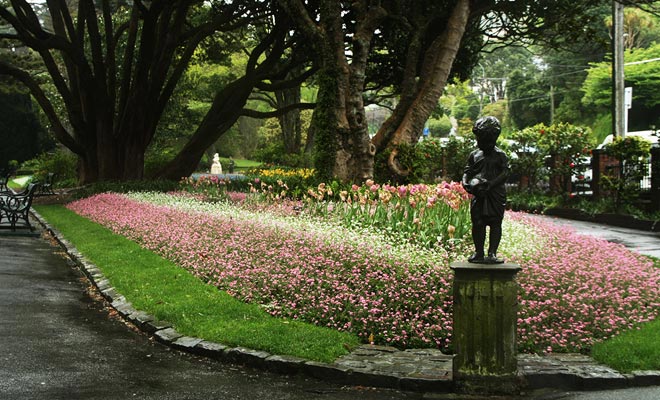
The Free Botanical Garden dates from 1868.
The great botanical garden connected by the red cable car is almost as old as the founding of the city itself. Its 26 hectares were planted for the first time in 1868. It overlooks the west coast with splendid views of Mount Victoria on the other side of the bay.
It's a great pleasure to admire the great varieties of rare flowers. Trails join fountains and ponds where ducks swim. From spring to early summer, 30,000 tulips color the landscape. I love the relaxing atmosphere, people who whisper and the bird songs.

The Lady Norwood Rose Garden has thousands of roses.
The Lady Norwood Garden section contains a hundred different rose species!
Fragrances floating in the air lead us to the greenhouse Begonia House. One discovers there are not only the flowers of the same name but also tropical plants and even carnivore ones! A lovely pond with floating water lilies is surrounded by an amazing collection of orchids.
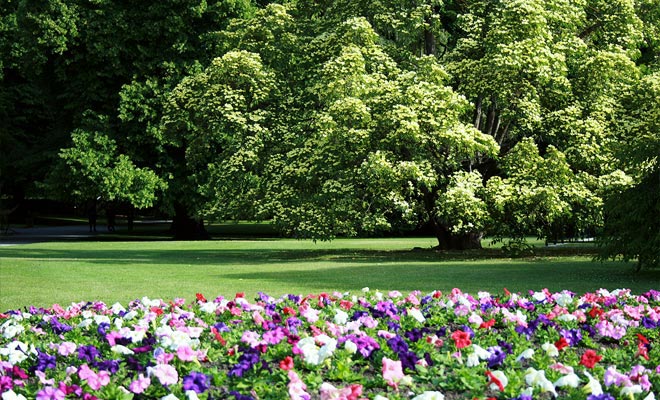
The Dell hosts the Jazz Festival.
In the heart of the garden, you can enjoy a large lawn to lie down and rest while following the clouds. This place is called “The Dell” and is famous for hosting outdoors jazz concerts, and film screenings during summer. We already did a museum today, so we won't visit the planetarium. But the Carter Observatory is wonderful, and reveals the secrets of navigation and the cosmology of ancient Maoris. You can also contemplate the sun with a special telescope filter and the constellations in the evenings.

The Karori sanctuary occupies the ancient reservoirs of the city.
We completed the tour of the park, but I have planned a surprise for you. First, we must leave the Botanical Garden to reach the Kelburn District.
A few blocks away, there is an imposing wall that is reminiscent of the enclosure of the dinosaurs in the classic movie “Jurassic Park”.
Zealandia, the Karori sanctuary was opened to the public in the year 2000. This huge reserve of 250 hectares is home to a preserved fauna and flora in a wild environment.
Thirty rare species lives here safe from predators. It is a real natural park in the heart of the modern city. And there is even a lake!
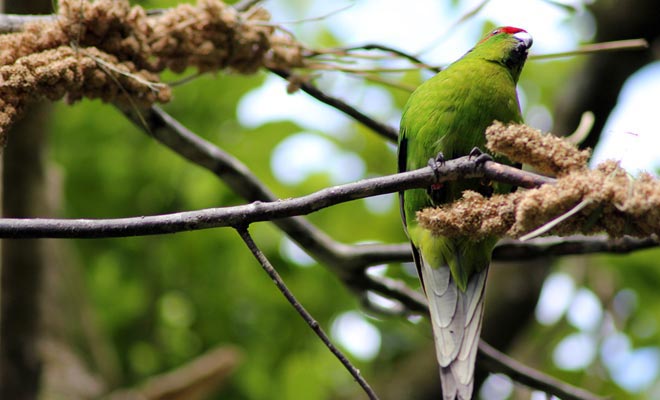
Wildlife species are kept safe from predators.
I'll let you go on an adventure in the company of a guide. You will need him not to get lost in the kilometers of trails through the forest, and he'll help you to spot the birds hidden in the trees.
You will find me near the entrance in the late afternoon, and I can assure you that your camera will be full of beautiful pictures of the Kiwis, Kaka, Tuatura and other beautiful creatures of Zealandia.
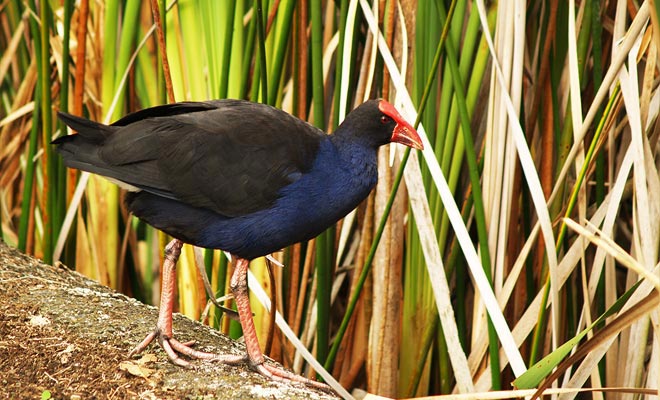
The tuatura is waiting for you in the forest.
Am I the only one to be hungry? You walked more than me, so I guess the answer is yes. It's time to return into the heart of the city!
Good Vibes from Cuba to Courtenay!
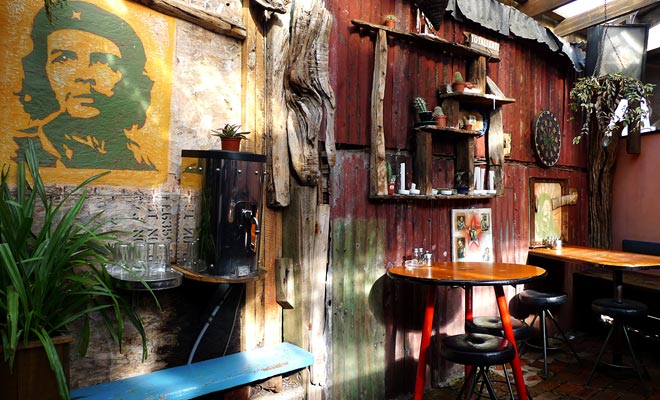
Cuba Street welcomes all the cuisines of the world.
Wellington's Cuba District is not a Cuban enclave in New Zealand. The neighborhood owes its name to one of the first ships of settlers who landed here in 1840.
This is a trendy area with live entertainment every street corner.
The bohemian atmosphere attracts young people strolling along the designer boutiques. I love the funky atmosphere, and I often visit the old music stores to find some curiosities.
Cuba Street is an old tramway track, now reserved to passersby. It is also the most famous street of the city.
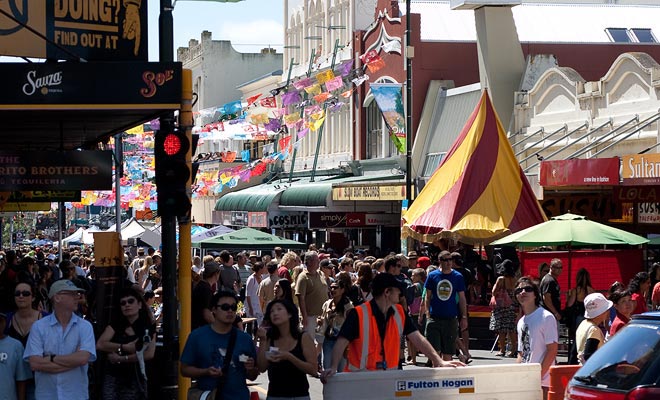
The Carnival of Wellington in Cuba St.
We have plenty of choice because Wellington has more cafés per inhabitant than New York! All types of cuisine are represented, but I advise you to book in advance.
ou should really try the Fidel's, which is my favorite café, decorated with the colors of Havana. You can order eggs (the speciality), pizzas and salads. Cocktails and milkshakes are a must, and if there is a table available in the small courtyard you should not hesitate!
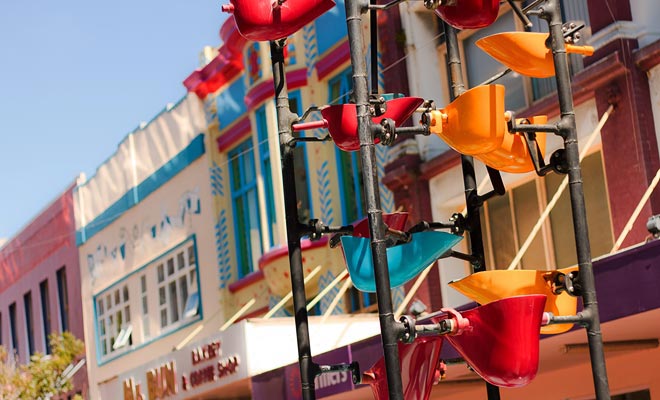
The famous fountain of Cuba Street marvels the children.
When I want something even better, I book the Logan-Brown in the same Cuba street. Completely different atmosphere, but not stilted, however, in the best gourmet restaurant in Wellington. Excellent restaurant, but quite expensive. Booking is not an option...
Now that night has fallen, we have two solutions. If you are exhausted, I'll show you the way to the hotel. But if you still have energy, I suggest extending the evening. Feeling motivated? Let's have a coffee first before leaving, they are known as the best in town.

Courtenay still hosts the premieres of Peter Jackson.
Courtenay is the most popular district and the hippest of Wellington.
Headquarters of the underground cultural life, there are many theaters, cinemas and nightclubs here. The neighborhood is just a few blocks from Cuba Street, we can walk there.
Along the way I will show you the Embassy Theatre where all Peter Jackson's films are projected for the first time before a worldwide release.
We must not be far from the Mighty Mighty, the trendiest musical bar of the moment.
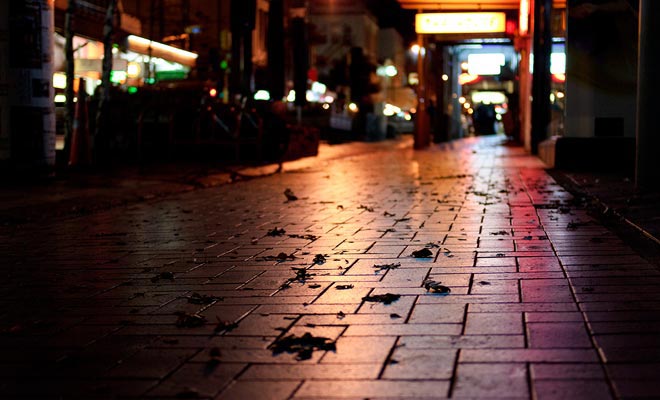
The ghost of Blanket Man haunts the streets of Wellington.
Hot atmosphere, but very “select”, for this place where you can attend live concerts. On the way back, you might spot the ghost of Ben Hana (the famous Blanket Man of Wellington de Wellington !) This eccentric local legend lived in Cuba Street, practically naked all day (until his sad death in 2012).
Wellington, Most Beautiful City in New Zealand?
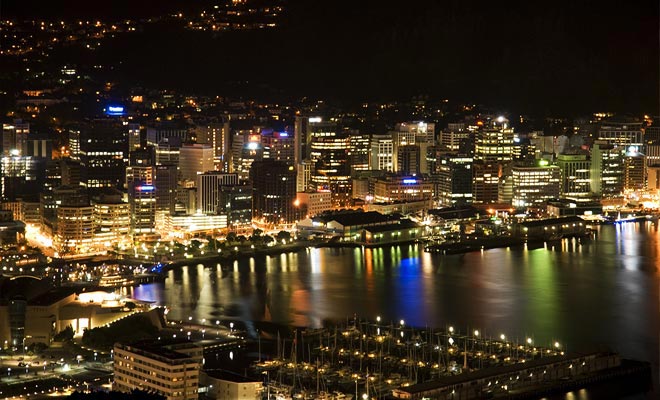
The view of the harbor from the top of Mount Victoria.
Wellington is a concentrate of so many positive aspects of New Zealand. You should plan two or three days to explore the different bays and neighborhoods we just began to discover all together.
Anyway, I hope you enjoyed my itinerary, and I'd be happy to help you plan a longer stay in the capital.
I have always considered the people of Wellington to be warm and very welcoming. This is no coincidence if the country's capital ranks at the 12th position in the Mercer list of the cities in the world where life quality is the best. The wind that sweeps the streets is perhaps its only weak point, but this is something one can get used to. Anyway, the wind did not annoy us today.
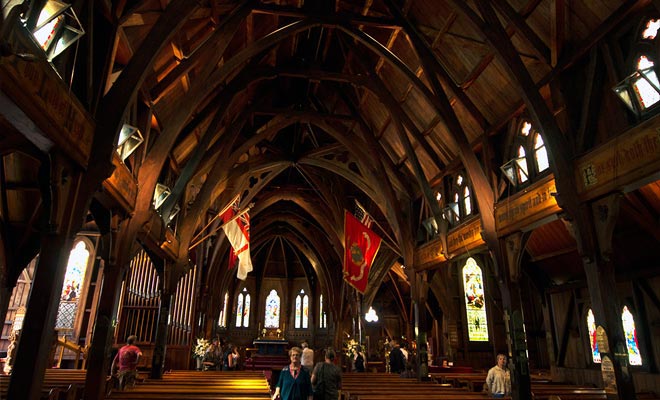
The wooden cathedral is worth a visit.
If the weather is bad, there are many indoor visits available, including the famous Te Papa. This museum is the gem of the city, and locals come for an average of 3 or 4 visits a year. For the permanent collections, of course, but also for highly original exhibitions. On my last visit, one of the best temporary exhibitions was devoted to video games!
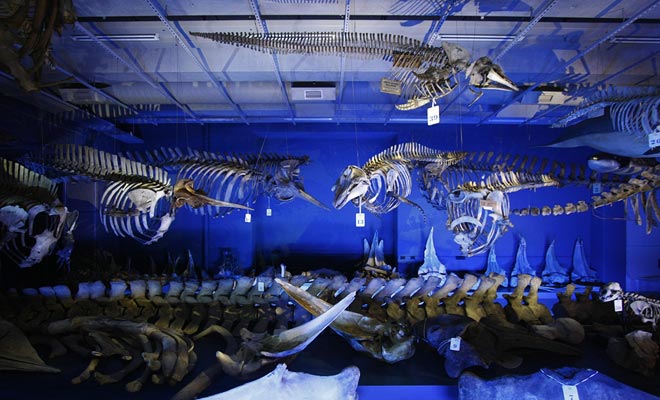
The Te Papa is one of the best museums in the world ...
eople argued a lot about the rivalry between the capital and Auckland. I do not see how we could choose between them, even with objective criteria.
Both cities have in common to be located in beautiful areas which allow wilderness outings. I prefer Wellington for its bay and the villas on the hillside, but this is my personal point of view.
Even with a lot of imagination, I do not see how I could have found the time to take you on Kapiti Island trip.
This island of 2,000 hectares was converted into a reserve and 1,400 kiwis live there. Only 50 visitors can visit the island every day. Suffice to say that this is a natural paradise that I will present in a future article.
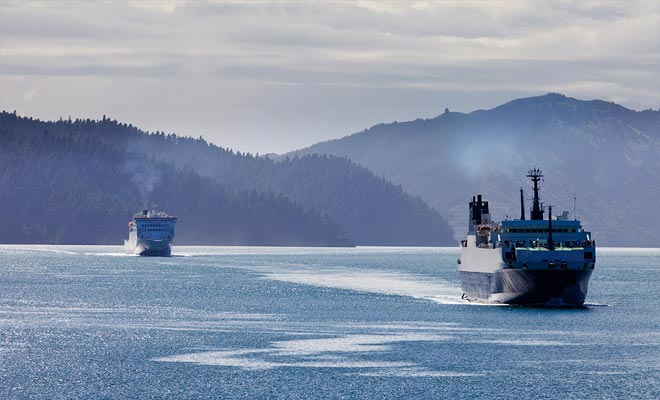
Take the ferry to Picton.
Wellington is a must for travelers crossing from North Island to the South Island of New Zealand.
The ferry crossing from Wellington to the city of Picton takes about 3 hours with several daily departures.
I'll take you to the ferry and we will meet again in the Abel Tasman National Park. Do not miss my articles on the cities of the South Island. Queenstown, Wanaka and Christchurch are available.

The crossing to the South Island lasts about three hours.
Until then, I leave you with our friend Ben the Kiwi, our guide whose family has long lived in Wellington. He used countless pairs of shoes to explore the steep streets of the city.
Ben will be happy to answer all your questions. In gratitude for his kindness, please send us pictures of your stay in Wellington, we will publish them on Kiwipal!


Questions & Answers.

What can I do for you? I lived in Wellington for many years. It's my favorite city even if I'm a fan of the Auckland Blues. It is always a pleasure to answer your questions about the capital of New Zealand.
- All topics ... 50 answers in total
- Museums and Visits 11 answers
- Traffic and Transport in the City 9 answers
- Te Papa Museum 7 answers
- Practical Information 6 answers
- Wildlife Reserves 6 answers
- Weather Forecast and Swimming 5 answers
- History of the City 4 answers
- Weta Cave 2 answers
Museums and Visits
- Can we visit the parliament?
The Beehive on Bowen Street can be visited and you can even attend public debates. The Old Government Building can also be visited in part, but it is essentially the interior of the building which is interesting for its large staircase made of rimu wood.New Zealand Parliament Official website
- Can we visit the former home of Katherine Mansfield?
The house of the most famous novelist of New Zealand is located in the Thorndon District, the oldest one of the city. Meet at 25 on Tinaroki Road for a guided tour of the Victorian villa where the author was born. Photos, excerpts of the works and the original furniture are to be seen.Katherine Mansfield Museum
- Why should we visit the national archives?
The original parchment of the Waitangi Treaty was rediscovered only in 1911. Other interesting documents are to be seen, like the petition of 30,000 signatures to claim women's right to vote (the request was a success , And New Zealand was the first country in the world to grant this right to women). The museum at 10 Mulgrave Street is free and open weekdays from 9 am to 5 pm and Saturdays from 9 am to 1 pm.
- Do you recommend visiting Church of St Paul?
This magnificent Gothic wooden cathedral is unique in its kind. The vault and the windows are remarkable! To visit absolutely if you pass in Mulgrave Street.
- Should we visit Town Belt?
This 425-hectare forest has many signposted trails that offer splendid views of the bay and the city. It is accessible via Grand Road Thorndon.
- Does the view from Mt Victoria deserves a visit?
For some it is the most beautiful point of view on the city. You can get there by car following Hawket Street then Palliser Road. A one and a half hour itinerary called "Mt Victoria Southern Walkway" crosses a bush and a pine forest. Cover yourself well, because the wind blows strong and it is particularly cool despite the low altitude.
- What can we see at the Wellington Museum?
The former customs warehouse of 1892 was converted into a museum. Everything you need to know about maritime life and the shipwrecks of the past is perfectly explained. On the second floor, holograms illustrate Maori legends. Go to Queens Wharf, 3 Jervois Quay. Open weekdays from 10 am to 5 pm and closed on weekends.Wellington Museum
- Where is the Botanical Garden?
At the arrival of the funicular that is borrowed on Lambton quay. It is open every day from sunrise to sunset.
- Do you recommend the Cable Car Museum?
This small museum exhibits the old steam funicular model. It is right next to the Botanical Garden at 1a on Upland Road, Kelburn. Its entrance is free, why not take a look? Doors open every day from 9:30 am to 5:00 pm, except on December 25th.Cable Car Museum
- Where can we watch rugby matches?
The Wellington Hurricanes Rugby team plays in the Westpac Trust Stadium. The schedules of the matches are on the official website of the stadium, but beware, the seats are usually booked in less than an hour!Rugby Hurricanes
- I thought I saw a French phone booth, did I dream?
Corsican artist Elie Cristiani installed a telephone booth that connects her native island to Wellington. By calling 33 4 95, you can listen to Corsican songs. Conversely, a New Zealand cabin was installed in Ajaccio. Go to Post Office Square to observe this strange curiosity.
Traffic and Transport in the City
- How much does the city tram cost?
A zone system is practiced and each zone costs $1,5 per adult and $1 per child. The daily bus pass (Starpass) also gives access to the night buses. It will cost you $12 but if you stay exclusively downtown, it only costs $6. The network map and the rates are on the official website:Wellington Trams
- How much does the Lambton Quay funicular cost?
Located at 280 Lambton Quay, the funicular connects the Botanical Garden in 3 minutes for $3 per adult and $1 per child. Departures every ten minutes.
- Are there bike tracks?
There are routes, but they are often dedicated to those who are not afraid to climb hills. Oriental Bay and the city center remains practicable and on flat ground. Mountain biking is more appropriate in the area and there are many circuits.
- Is there an airport?
The airport is 8 km to the southeast. It takes 15 to 20 minutes by car to reach the center. You can travel by bus ($8), by shuttle ($16) or by taxi ($30).Wellington airport
- How to reach Wellington by bus?
Innercity coaches regularly connect Wellington to Auckland. But the trip lasts 11 hours with breaks.
- Can we come by train?
From Auckland, the Overlander joins Wellington in about 12 hours. Do not be intimidated by the duration, the scenery is breathtaking all along the way.Overlander Tranz Scenic
- Which ferry companies offer to cross to the South Island?
Interislander and Blue Bridge need about 3h15 to reach Picton on the South Island. Three to four ferry return trips take place every day. Rates vary depending on the date and whether or not you are boarding with a vehicle. I will let you consult the websites of these two companies. Knowing that Blue Bridge practices the lowest rates, but leaves Glasgow Wharf while Interislander is based in Waterloo Quay which is more convenient.InterislanderBlue Bridge
- Is it easy to drive in the city?
The narrow streets often inclined and one-way. If you drive a motorhome, I do not even advise you to drive downtown. Even though it is expensive, the car park is a solution to consider.
- Where can I park in the city?
If you plan to park along the sidewalk, the parking meter rate is set between $1,5 and $4 depending on the location. Parking is free on weekends. If you opt for an underground parking, the rate will be higher: Open from 6 am to midnight. Visit the official site for the list of the parking's locations.Wellington Carpark
Te Papa Museum
- Where can you find more information about Te Papa?
The museum's official website is there for this purpose.Te Papa Museum (official)
- Is the Te Papa Museum paying?
Access to the permanent collections is free, but a small offering will be welcomed. Temporary exhibitions are generally to be paid.
- What are the opening hours of Te Papa?
The museum is open daily from 10 am to 6 pm and until 9 pm on Thursdays.
- Can we photograph exhibitions of Te Papa?
Unless otherwise stated, you are allowed to take pictures. On the other hand, some Maori objects are sacred ("tapu") and you will not be granted to photograph them.
- Is Te Papa accessible to people with disabilities?
The access is accessible in wheel chairs from the car park through the exhibitions ( there are also adapted toilets). At the level of the visit, the videos are systematically subtitled for people who are hard of hearing.
- Does Te Papa has an online store?
Yes, visit the official website of the shop at this address:Te Papa Store
- What are the opening hours of Te Papa Café?
The restaurant is open daily from 9 am to 5 pm.
Practical Information
- How to get more information about Wellington?
You can consult the official website of the city.Wellington Official Website
- Where is the Wellington iSite?
You'll find it at 101 Wakefield St, on the Civic Center esplanade. Open daily from 8:30 am to 5 pm except on December 25th.Wellington iSite
- How many people live in Wellington?
We are now approaching 180,000, but if we count the suburbs the figure rises to 400,000.
- What is the size of the CBD?
The CBD are only 2.5 km away and can be easily reached on foot.
- Where to find a free internet connection?
You can connect for free to the Te Papa Museum's WiFi network near the Civic Center.
- Can we camp in the surrounding area?
You are not allowed to camp in town. The first area reserved for camping is 13 km from the city center and is called "Top 10 Hutt track".Wellington Top 10 Campings
Wildlife Reserves
- How to visit Kapiti Island?
This mountainous island, 10 km long and 2 km-wide, is served by Kapiti Marine Charter and Kapiti Tours. These are the only companies allowed to provide a 20-minute shuttle to the bird sanctuary. I recommend choosing a guided tour even if it is possible to circulate all alone. In all cases, a permit must be asked to the Department of Conservation.Kapiti Marine Charter
- Can we see the South Island off Wellington?
You have to go to Island Bay on sunny days. You may sometimes see the summit of Mount Kaikoura on the other side of the strait.
- Do you recommend visiting Otari-Wilton's Bush?
Absolutely ! It is a large forest 5 km from the center. There are three entrances, but the main one is located at 160 Wilton Road. It is the ideal place to discover hundreds of varieties of plants and 800-year-old Rimu trees!
- What are the entry requirements in Zealandia?
You can come any day of the week from 10 am to 5 pm on Waiapu Rd and pay $15 per adult and $7 per child. At dusk, you can accompany an ornithologist to listen to the song of the birds.Zealandia Official Website
- Is there a zoo in Wellington?
Yes, it is even the oldest Zoo in the country. Built in 1906, it houses 350 animals in their natural habitats reconstituted without windows or fences. Come admire giraffes, kangaroos, monkeys, tigers ... and, of course, the famous Kiwi to be observed in the darkness. Open daily from 9:30 am to 5 pm for $18 per adult and $9 per child.Wellington Zoo
- Where can fur seals be seen?
I recommend the Seal Coast Safari. This excursion takes you to discover the colonies of fur seals that populate the nearby bays.Seal Coast
Weather Forecast and Swimming
- What kind of weather can we expect in Wellington?
The oceanic climate translates into cool summers and mild winters. Climate is neither too hot nor too cold and precipitation is quite frequent. See the weather of the day on this page.Wellington weather
- Is the wind blowing as hard as it is claimed?
The nickname "Windy Welly" is not usurped. Gusts blow on average at 60 km / h and 200 days a year. The record of 248 km / h was established in 1962.
- Can we swim in Wellington?
In this region of the South of the North Island, the water is a bit cool to bathe outside the sunny summer days. That said, the beaches are very clean and perfect for sunbathing.
- Can we surf?
Yes, you will find good waves at Lyall Bay, Breaker Bay, Houghton Bay, and Tihati Bay. For once, wind is an advantage, especially if you practice Kitesurfing.
- Can we go diving?
The area is full of islands and coasts where you can dive on wrecks (they are numerous in the bay). But the most spectacular place is in the Kapiti Island Marine Reserve. Do not hesitate to take lessons at Splash Gordon at 432 "The Esplanade", Island Bay, before coming to admire the anemones.Kapiti Island diving with Splash Gordon
History of the City
- Where does the city name come from?
A thousand years ago, the legendary Polynesian navigator Kupe approached the shore of Wellington Harbor. Western settlers did not begin to settle until 1840. Previously, neither Abel Tasman in 1642 nor Captain Cook in 1773 managed to dock during their expeditions due to high winds. The first camp was named "Britannia" before being renamed in honor of the Duke of Wellington, the victor of Napoleon.
- Who was the founder of the city?
William Wakefield arrived in the bay aboard the Tory in 1839. At that time, only one Occidental lived in a Maori family. Wakefield will acquire lands before the British crown gets the monopoly to deal with the local people. This English citizen hoped to found the capital of the country, but he will not live long enough to see his dream come true. Largely ignored by the inhabitants because of his tumultuous past (he had been in prison), the founding father does not even own his own statue in town.
- Why did Wellington become the capital of the country?
Auckland was the capital and the most populous city in 1865. Wellington had only 4900 inhabitants at the same period. The rumor of a possible secession from the South Island where the gold mines were found had spread. To better control trade and avoid confrontation, the government seat was moved to Wellington.
- Are there earthquakes in the area?
The city is shaken by several small earthquakes each year. A major fault is located just below the city center, which has led to a controversy over the construction of Te Papa museum near the seafront.
Weta Cave
- What films were made in the Weta studios?
These are often sequences with special effects that are shot in Wellington. Even if entire films are developed in New Zealand. Here are some famous productions: King Kong, Avatar, Narnia trilogy, District 9, Tintin, Hobbit and Lord of the Rings trilogies, Prometheus, Avenger ...
- What can we visit at Weta Cave?
There is a small museum dedicated to the universe of Tolkien. A gigantic Gollum welcomes you at the entrance of the shop. The fans of the Lord of the Rings will be delighted.Weta Cave
On the Country Map
Wellington is in the region of ??the same name on the North Island.

